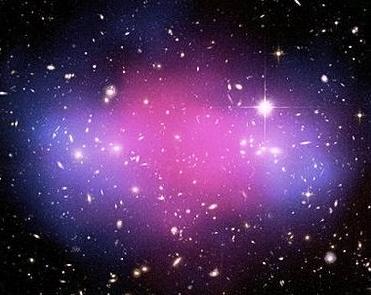
This August 2008 image taken by Hubble Space Telescope and Chandra X-ray Observatory shows a clear separation between dark and ordinary matter during a clash 5.7 billion light years from Earth. Photo Credit - NASA
PARIS (BNS): An anomalous energy signal detected by an orbiting satellite could provide some vital clue to the enigmatic substance known as dark matter, according to European astronomers.
The researchers, in a study appearing in the British journal Nature, have revealed that they have picked up a signature of this strange phenomenon, but they say their mysterious signal must be further investigated before making any claim that they have actually �discovered� dark matter.
Some years ago, astrophysicists calculating the amount of matter in the Universe arrived at the startling discovery that ordinary material - atoms - comprises perhaps as little as 5% of the stuff in the cosmos.
The space-based experiment, known as Pamela, was launched in June 2006, and carries instruments designed to investigate dark matter particles.
The rest, scientists believe, comes from the �dark� sector: matter and energy that appear to be pervasive but whose nature remains a puzzle. Dark matter, which is believed to be accounting for 23% of the Universe, has been detected only indirectly, through the gravitational pull it exerts on visible matter.
The substance has ignited an intensive debate, including the hypothesis that dark matter is a new dimension of the Universe.
Another theory is that dark matter must be a new particle, or particles, that interact so weakly with ordinary matter that it does not produce light-emitting reactions.
The other theory is that dark matter is linked to "supersymmetric" particles, or partners to known sub-atomic particles.
A team led by Piergiorgio Picozza of the University of Rome Tor Vergata looked over data sent back by a European satellite called PAMELA between July 2006 and February 2008 and found an unusual abundance of positrons, the counterpart to the electron, in cosmic rays at a high part of the energy spectrum.
Around 72 percent of cosmic matter is dark energy, which could be responsible for the accelerating expansion of the Universe.
 Previous Article
Previous Article













The Indian Air Force, in its flight trials evaluation report submitted before the Defence Ministry l..
view articleAn insight into the Medium Multi-Role Combat Aircraft competition...
view articleSky enthusiasts can now spot the International Space Station (ISS) commanded by Indian-American astr..
view article